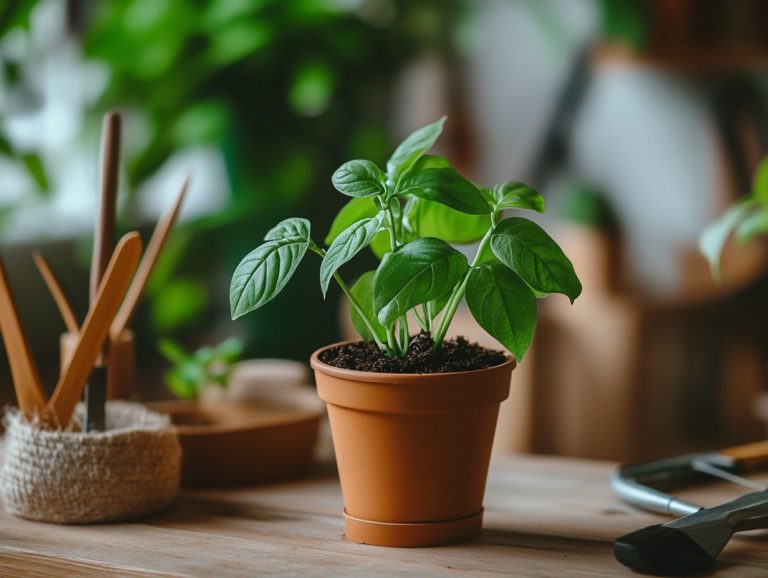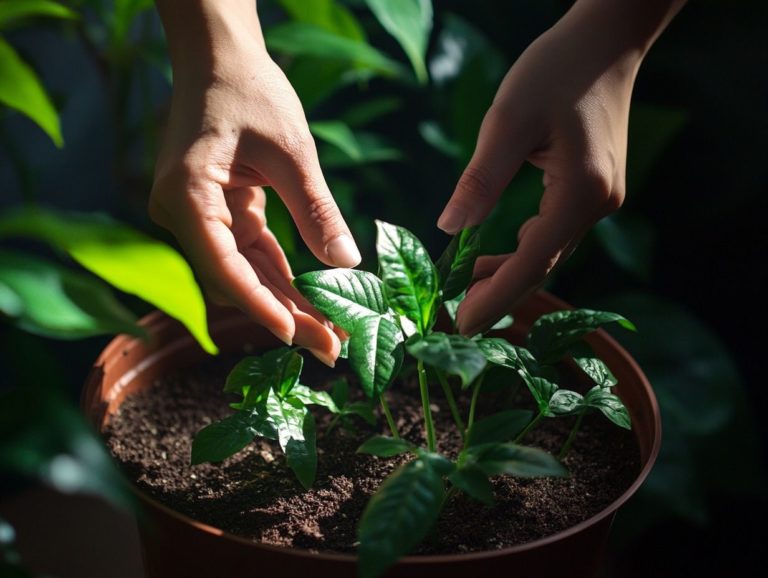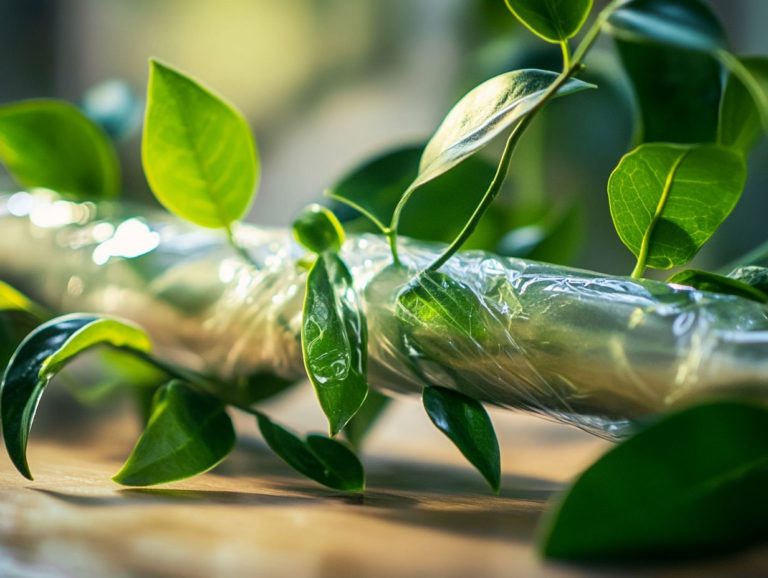How to Propagate Sansevieria Plants
Sansevieria, commonly known as snake plants, are not only exquisite additions to your home but also incredibly resilient. If you re considering expanding your collection or sharing these green wonders with friends, propagation is the perfect route to take.
Delve into the various methods of propagating Sansevieria, from leaf cuttings to the intriguing technique of air layering. You ll uncover valuable tips for successful propagation, identify common pitfalls to steer clear of, and learn how to care for your new plants.
Get ready to discover how to nurture your Sansevieria and watch your indoor garden explode with life!
Contents
- Key Takeaways:
- Why Propagate Sansevieria Plants?
- Methods of Propagating Sansevieria Plants
- Tips for Successful Propagation
- Common Mistakes to Avoid
- Maintenance of Propagated Sansevieria Plants
- Frequently Asked Questions
- What are the different methods to propagate Sansevieria plants?
- When is the best time to propagate Sansevieria plants?
- Can Sansevieria plants be propagated in water?
- How long does it take for Sansevieria plants to root?
- Do Sansevieria plants need special care after propagation?
- Can Sansevieria plants be propagated from seeds?
Key Takeaways:
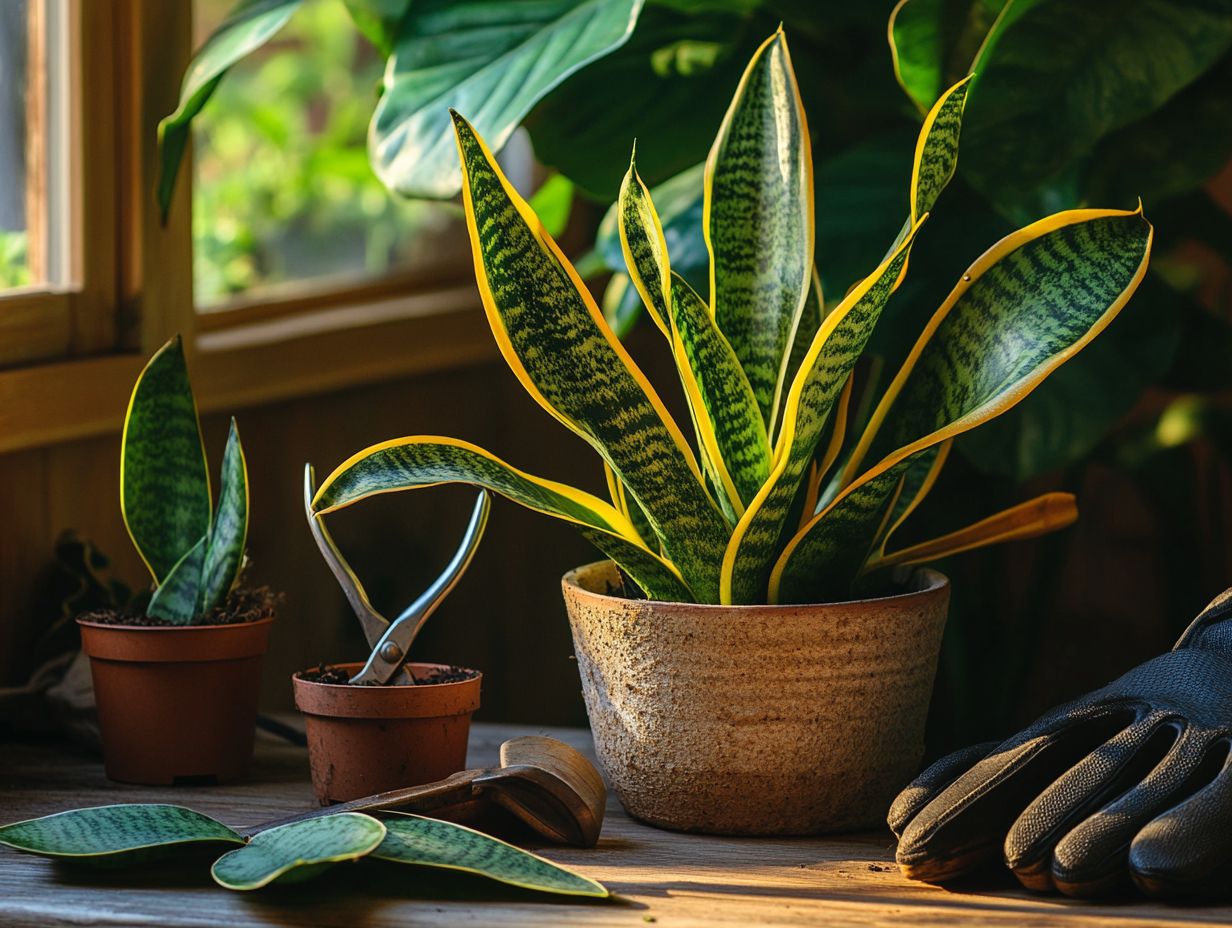
- Propagating Sansevieria plants allows for easy and cost-effective expansion of your plant collection.
- Leaf cuttings, division, and air layering are effective methods for propagating Sansevieria plants.
- Proper care and maintenance, as well as avoiding common mistakes, are crucial for the successful propagation of Sansevieria plants.
Overview of the Plant and Its Varieties
The snake plant, scientifically known as Sansevieria or Dracaena trifasciata, is the houseplant you ve been hearing about. It is celebrated for its striking, upright foliage and remarkable adaptability to various environments.
This versatile gem comes in many types, each showcasing unique patterns and hues that can elevate your interior decor while fostering a healthier living space.
Its knack for thriving in indirect sunlight and surviving without much care has made it the go-to choice for both novice and expert gardeners. This solidifies its status in container gardening and sustainable practices.
Among the crowd favorites are the Laurentii , with its vibrant yellow margins gracing elongated leaves, and the Moonshine , boasting silvery-green foliage that adds a chic flair to any room. Not only do these varieties enhance aesthetic appeal, but they also play a role in purifying the air, ensuring your home remains a sanctuary of health.
For those just stepping into the world of container gardening, these hardy plants are a breeze to care for and are forgiving when it comes to erratic watering schedules. By welcoming different Sansevieria varieties into your indoor spaces, you can relish the beauty of lush foliage while cultivating a thriving, resilient atmosphere.
Why Propagate Sansevieria Plants?
Propagating Sansevieria plants, often referred to as snake plants, presents a wealth of advantages that are sure to captivate any gardening enthusiast.
By employing straightforward techniques such as leaf cuttings or division, you can effortlessly expand your collection while embracing a sustainable approach to plant care.
This practice builds a sense of community among fellow plant aficionados and enriches your indoor environment, enhancing both air quality and aesthetic appeal.
Benefits and Uses of Propagation
The benefits of propagating snake plants are numerous. You can create young plants and preserve healthy leaves that enhance the aesthetic and functional value of your indoor space.
By embracing straightforward propagation techniques like cuttings and division, you can transform a single plant into many, ensuring a lush, vibrant display that elevates your decor while improving air quality and overall ambiance.
Cultivating multiple young plants helps you save money by reducing the need for new purchases, all while deepening your connection with nature. As those healthy leaves flourish, they play a vital role in filtering toxins from the air, creating a healthier living environment.
Engaging in these gardening practices can become a therapeutic escape, allowing you to nurture your green companions while savoring the satisfaction of witnessing your efforts thrive. The practical applications of propagation also reveal a world of design possibilities, adding versatility to your home garden setup.
Methods of Propagating Sansevieria Plants
Several elegant methods are available to you for propagating Sansevieria plants, commonly known as snake plants. These techniques leaf cuttings, division, and air layering each present distinct benefits suited to various gardening styles.
Leaf cuttings make for a straightforward approach to multiply your plants. Division works wonders for those robust, established specimens. Air layering, on the other hand, offers a fascinating way to promote root growth while the new plant remains connected to its parent.
By mastering these propagation methods, you can enhance your gardening experience, ensuring your plants thrive in health and vitality.
Leaf Cuttings
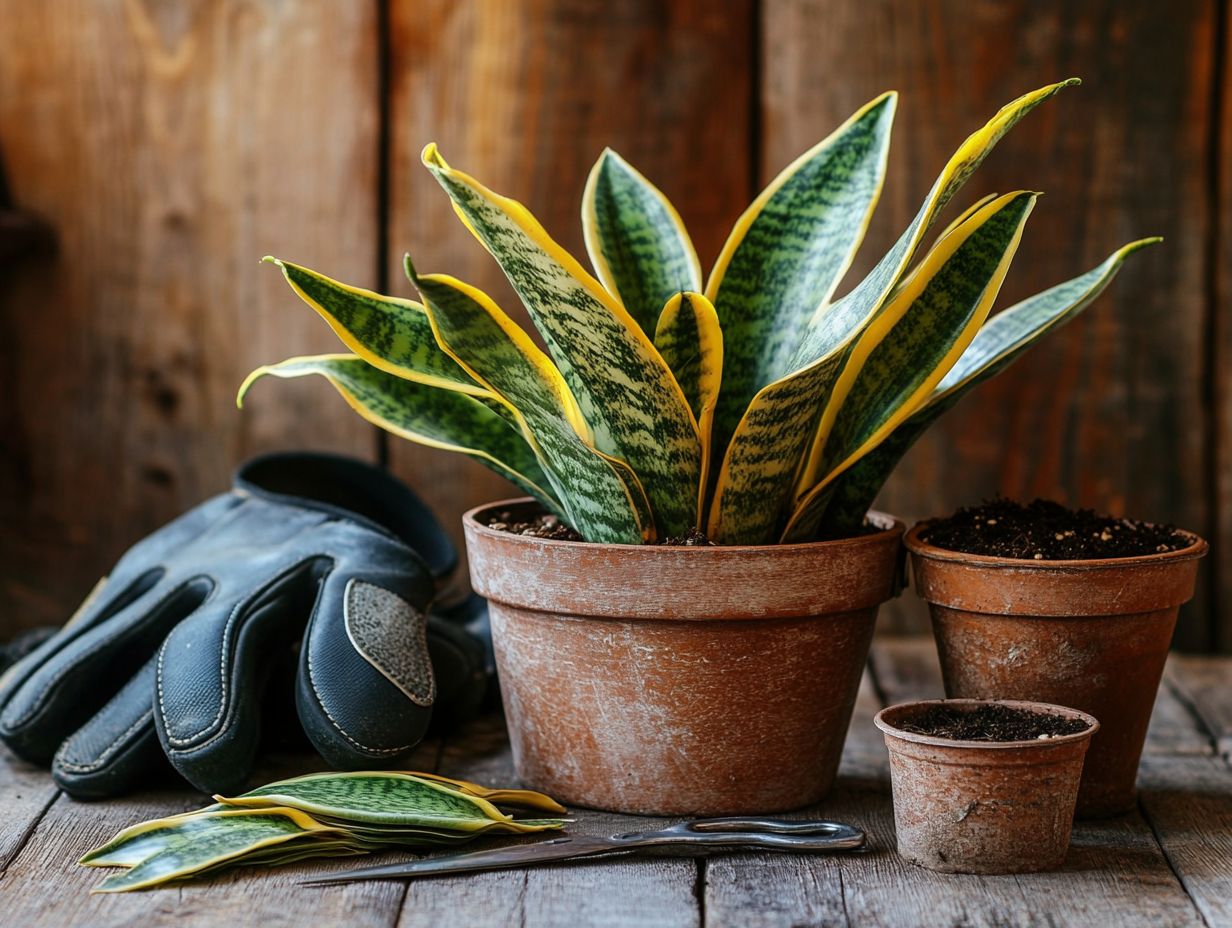
Leaf cuttings are a favored method for propagating Sansevieria, allowing you to effortlessly create new plants from healthy leaves. This technique ensures effective rooting and growth.
When using leaf cuttings, choose healthy, mature leaves. Cut them into sections and treat them with rooting hormone before placing them in moist potting soil. This method boosts root development and helps young plants thrive in indirect sunlight, enhancing your indoor landscape.
To get started, select leaves that are vibrant and free from any signs of disease or pests. Choose leaves that are at least 6 inches long for the best results. After harvesting the leaves, cut them into 3-4 inch sections, slicing at a slant to maximize the surface area for rooting.
After applying rooting hormone to the cut ends, gently position them in a mixture of potting soil, ensuring they stand upright. Lightly water the soil and cover the container with a plastic bag to maintain humidity. Place it in a location that receives indirect sunlight.
Keep a close eye on the moisture levels in the soil. After a few weeks, you should start to see new growth an exciting sign that roots have successfully developed.
Division
Division is a remarkably effective method for propagating your beloved Sansevieria plants. This technique allows you to create young specimens from established ones by carefully separating their underground stems. It boosts plant health and gives you more beautiful snake plants to enjoy!
To successfully divide your Sansevieria, timing is crucial; spring or early summer during the growing season is the ideal period when the plants are at their most vigorous. Equip yourself with the right tools, such as a sharp, sterile knife or a garden spade, to minimize any damage to the roots. Additionally, if you’re interested in expanding your indoor plants, learning how to propagate spider plants can be quite beneficial.
Once you ve made the divisions, prepare a well-draining soil mix that includes materials like perlite or coarse sand to enhance aeration. After planting the divisions, place them in bright, indirect light and water sparingly, allowing the roots to establish themselves without the risk of rotting. Keeping an eye on humidity levels and avoiding extremes will also greatly support the growth and overall health of your young plants.
Start your journey today and see how quickly your Sansevieria can grow!
Air Layering
Air layering is an advanced propagation technique for your Sansevieria plants that encourages root growth while keeping the new plant attached to the parent. This allows for successful propagation without disrupting the main plant.
The process involves creating wounds on the stem, wrapping them with moist material to retain humidity, and ensuring the temperature is just right to promote rooting.
Once the roots develop, you can separate the new plant and pot it. This gives you a distinctive way to expand your snake plant collection!
To successfully execute air layering, gather your materials: clean plastic wrap, sphagnum moss, and a sharp knife. Start by selecting a healthy stem and making a slanted cut about one-third of the way through. This opens it up for moisture absorption.
Next, wrap the cut area with damp sphagnum moss and cover it tightly with plastic wrap to lock in that precious humidity.
It’s crucial to place your plant in a warm environment ideally between 70 F and 80 F because this temperature range promotes optimal root development. Be sure to check the moisture level inside the wrap regularly, ensuring the moss stays damp.
By maintaining these conditions, you ll encourage robust root growth, setting you on a successful propagation journey!
Tips for Successful Propagation
- The successful propagation of snake plants depends on a few essential strategies that promote healthy growth and vibrant foliage.
- Focus on key elements like optimal lighting, soil moisture, and preventing root rot for the best results.
- Stick to a regular care schedule and keep an eye on their health. This will enhance your propagation journey!
Important Factors to Consider
When you set out to propagate Sansevieria plants, there are several vital factors to consider that can dramatically influence your success. This includes selecting the right type of soil, managing your watering practices, and creating ideal environmental conditions.
Choosing potting soil that retains moisture without becoming waterlogged is crucial. Additionally, ensuring that your plants receive the right balance of water and light will set the stage for thriving growth.
Understanding these elements will lead to a more fruitful propagation experience and healthier young plants!
Soil is pivotal in providing the nutrients and drainage that these resilient plants require. A well-draining mix, often featuring perlite or coarse sand, will help you avoid root rot, a condition where roots decay due to excess moisture, while still retaining moisture.
Your watering frequency should align with the seasons for the best results! During the warmer months, slightly more frequent watering can work wonders, while in cooler months, extending the interval between waterings is essential to prevent over-saturation.
Sansevieria flourishes in bright, indirect light, making it imperative to position them correctly to optimize their growth. With the right care, your propagation efforts can yield vibrant, robust new plants that will be the envy of any indoor garden! For tips on how to propagate succulents successfully, be sure to explore the best practices.
Common Mistakes to Avoid
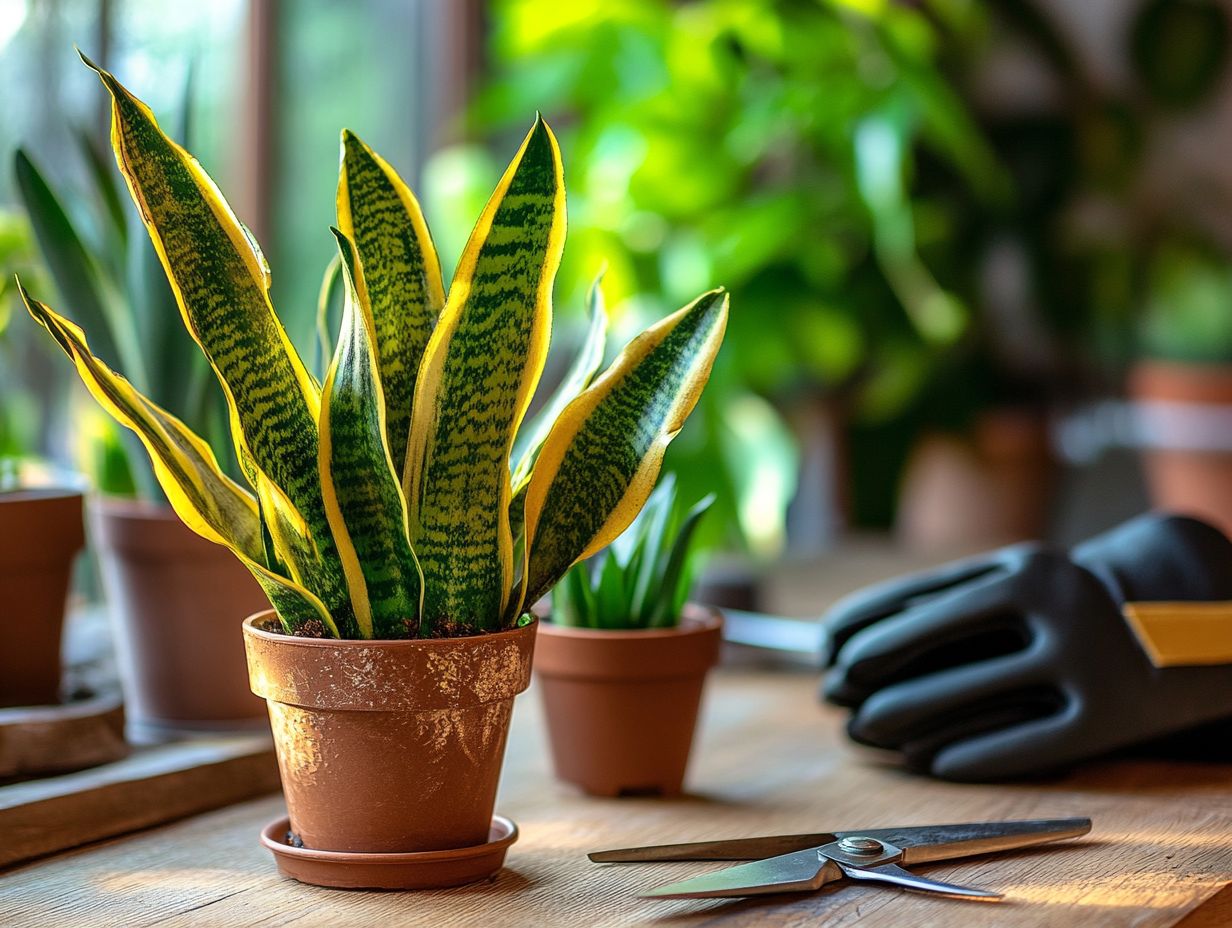
- Avoiding common mistakes when propagating Sansevieria plants is essential for ensuring their health and vitality!
- Issues such as root rot and pests can significantly impede growth.
- Many gardeners underestimate the importance of maintaining optimal humidity levels and adhering to proper watering practices, leading to unhealthy plants.
- By staying vigilant about these pitfalls, you can cultivate a thriving environment for your propagations and build a stunning collection of snake plants.
Don t wait! Start your propagation journey today and watch your collection grow!
Issues to Watch Out For
Several issues can arise during the propagation of Sansevieria plants that may compromise their health. Root rot and pest infestations are among the most detrimental. You must maintain the best temperature and humidity levels to prevent these problems, as fluctuations can stress your plants, making them susceptible to disease.
By being vigilant about these issues, you can take timely action and foster a healthy environment for your propagated plants.
For instance, you might notice signs of root rot manifesting as yellowing leaves. This indicates inadequate drainage or excessive moisture in the soil. Pest infestations from mealybugs or spider mites can reveal themselves through changes in leaf texture or discoloration.
Regularly inspect your plants and adjust conditions as needed. Keeping temperatures stable, ideally between 70 to 85 F, helps mitigate stress and promotes robust growth. Recognize these signs early to implement preventive measures, ensuring a successful propagation journey.
Maintenance of Propagated Sansevieria Plants
Proper maintenance of your propagated Sansevieria plants is crucial for ensuring their growth and longevity. Focus on care practices that promote healthy leaves and overall plant vitality.
By regularly attending to light conditions and pest management, you can significantly enhance the success of your propagated plants. This attention will allow them to thrive in their new environments and contribute meaningfully to your garden maintenance efforts.
Care and Maintenance Tips
To promote the health and longevity of your propagated Sansevieria plants, adhering to specific care and maintenance tips is essential. Start by selecting appropriate soil that allows for adequate drainage. Understand the watering needs to prevent overwatering, and position your plants to receive indirect sunlight, which is optimal for their growth.
By following these guidelines, you can cultivate vibrant and flourishing snake plants and learn how to propagate your favorite houseplants to elevate your indoor space.
A well-draining potting mix, ideally designed for succulents, is essential to prevent root rot in these hardy plants. Allow the soil to dry out completely between waterings, as Sansevieria is quite tolerant of drought conditions. Typically, watering every two to three weeks will suffice, though this may vary depending on the humidity levels in your environment. If you’re interested in expanding your collection, check out this guide on how to propagate ZZ plants.
Keeping the plants in a bright area with filtered light will promote healthy growth and vibrant leaf coloration. By considering these factors, you ensure that your snake plants thrive beautifully in any home.
Frequently Asked Questions
What are the different methods to propagate Sansevieria plants?

There are three main methods to propagate Sansevieria plants: division, leaf cuttings, and rhizome cuttings. Each method requires different techniques and has varying success rates.
When is the best time to propagate Sansevieria plants?
The best time to propagate Sansevieria plants is during the growing season, typically in the spring and summer months. This is when the plant is actively growing and has a higher chance of successful propagation.
Can Sansevieria plants be propagated in water?
Yes, Sansevieria plants can be propagated in water. This method involves placing the cuttings in a container filled with water and ensuring that the water is changed regularly. However, it is not the most recommended method as it can lead to root rot.
How long does it take for Sansevieria plants to root?
The time it takes for Sansevieria plants to root depends on the method used for propagation. Dividing the plant can take a few weeks, while leaf cuttings can take several months. Rhizome cuttings usually take around 4-6 weeks to root.
Do Sansevieria plants need special care after propagation?
Sansevieria plants do not need any special care after propagation. However, keep the soil lightly moist and avoid direct sunlight until the plants are fully established. Regular care and maintenance can help the plants thrive.
Start propagating today and watch your indoor garden flourish!
Can Sansevieria plants be propagated from seeds?
Yes, Sansevieria plants can be propagated from seeds. However, this method is not very common.
Seeds can take a long time to sprout. They might not even have the same traits as the parent plant. For quicker results, try propagating through division or cuttings. This method is much easier and offers more reliable plants!




